Translate this page into:
Intraoperative Computed Tomography Scanner-Guided Craniovertebral Junction Surgery in a Patient with an Occipitalized C1
Mohammad Ashraf, BMedSci (Hons) 33 Glenmill Crescent Glasgow G53-7HL United Kingdom mohammad_5676@hotmail.com
This article was originally published by Thieme Medical and Scientific Publishers Pvt. Ltd. and was migrated to Scientific Scholar after the change of Publisher.
Abstract
Abstract
Craniovertebral junction surgery is associated with unique difficulties. Type 2 odontoid fractures (Anderson and D Alonzo) have a great potential for nonunion and malunion. These fracture patients may require a circumferential decompression and fixation. The addition of intraoperative CT with neuronavigation greatly aids in craniovertebral junction surgery. We operated on a 59-year-old-male with a type 2 fracture with posterior subluxation of C1 anterior arch and a cranially displaced odontoid peg. First, a transoral odontoidectomy was performed followed by a craniocervical fixation. Occipital plates and C3–C4 lateral mass screws were used as C1 was discovered to be occipitalized intraoperatively and atlantoaxial facet joints could not be reduced as discovered by intraoperative CT resconstruction. Intraoperative CT scan was crucial to this circumferential decompression and fixation, allowed us to resect the odontoid peg safely and completely and to confirm adequate screw trajectory making this complex surgery easier for us and safer for the patient. The patient was discharged 4 months after admission with stable neurology. Intraoperative CT was fundamental to correct decision making.
Keywords
intraoperative CT scanner
type 2 odontoid fracture
occipitalized C1
craniocervical junction surgery
craniovertebral junction surgery
Introduction
Injuries to the craniovertebral (CV) junction account for a small proportion of spinal cord injuries, are usually associated with high energy trauma and affect the skull base at the occipital bone and the C1 and C2 vertebrae.1 2 The area is anatomically complex, its injuries peculiar and instability of this area can have devastating neurological consequences. As such spinal surgery in this area and its consideration are different from subaxial cervical spinal surgery.2
The Anderson and D Alonzo type II fracture occurs at the base of the odontoid process or superior to the junction with the vertebral body.3 These fractures are usually unstable, and surgery indicated as nonunion rates between 40 and 80% is reported.4 5 We present a case of a 59-year-old male patient who presented with a CV junction instability that indicated an anterior decompression and posterior fixation. We report the use of our intraoperative CT (iCT) scanner with neuronavigation and its benefit in such a procedure.
Case History
A 59-year-old male presented to our outpatient clinic complained of neck pain, quadriparesis, and right-sided torticollis. He was involved in a fall from his donkey cart one and a half month prior in a road traffic accident. There was spontaneous movement in all four limbs and neurological examination revealed intact sensation and normal reflexes, 2+ (Deep Tendon Reflex scale), with motor power of four out of five in all limbs (MRC grading scale). Tone, sensation and gait were intact. Plantar reflex was normal. The patient brought his only previous investigation, a lateral X-ray of cervical spine which revealed instability at the CV junction with a posteriorly displaced anterior arch of C1 and invisible odontoid peg which was fractured from the body of C2 (Fig. 1).

-
Fig. 1 Lateral X-ray cervical spine with craniovertebral junction instability with odontoid fractured and subluxation anterior to the anterior arch of C1 and cranially.
Fig. 1 Lateral X-ray cervical spine with craniovertebral junction instability with odontoid fractured and subluxation anterior to the anterior arch of C1 and cranially.
Upon admission to our department, Philadelphia Collar was applied the first day followed by skull traction for 2 weeks. After the initial 2 weeks he developed a pin site infection, the traction was removed, and 1 g of ceftriaxone was initiated twice daily. Upon resolution of infection traction was reapplied at a different site for 1 week. Piroxicam 2 mg twice daily was administered as an analgesic and tizanidine 2 mg twice daily as a muscle relaxant.
CT scan of the cervical spine with three-dimensional reconstruction revealed a C2 type II fracture (Anderson and D Alonzo) with an anterior and cranial right-sided displacement of the odontoid peg and atlantoaxial subluxation causing cervical myelopathy. MRI of cervical spine showed compression and thinning of the cervical spinal cord. The odontoid fracture warranted an anterior decompression and an occipital-cervical fixation which was planned as a two-stage procedure.
Surgical Procedure
First, an iCT cum neuronavigation-guided transoral odontoidectomy and removal of the anterior arch of C1 was done. The patient while lying supine had Mayfield 3 pin infinity skull clamp fixed to his skull with traction locked. A perioperative CT scan (Fig. 2A) was acquired and transferred to the neuronavigation system for surface registration. Surface registration was done with a 1.2 mm real time accuracy of the neuronavigation system. We proceeded with a transoral odontoidectomy, removing the anterior arch of C1 and a bony fragment of the odontoid. After this a second CT scan (first intraoperative scan) was done to check for any residual bony fragment and to orientate our self to the midline of the surgical field in real time. This scan confirmed the remains of a lateral bony bar (Fig. 2B) which was removed and confirmed with a third CT scan (second intraoperative scan) (Fig. 2C). Three-dimensional reconstruction however revealed that C1/C2 could not be reduced, and facet joints were locked. The wound was closed in layers.

-
Fig. 2 (A) Perioperative and first CT scan for neuronavigation and surface registration. (B) First intraoperative CT scan (second overall scan) following transoral odontoidectomy and removal of anterior arch of C1 confirming residual bony bar. (C) Second intraoperative CT scan (third overall scan) confirming removal of residual bony fragment.
Fig. 2 (A) Perioperative and first CT scan for neuronavigation and surface registration. (B) First intraoperative CT scan (second overall scan) following transoral odontoidectomy and removal of anterior arch of C1 confirming residual bony bar. (C) Second intraoperative CT scan (third overall scan) confirming removal of residual bony fragment.
In the second stage of craniocervical fixation it was discovered that the patient had an occipitalized C1. Along with an unreduced atlantoaxial joint it was decided to perform fixation with occipital plate and C3–C4 lateral mass screws. Screw trajectory was confirmed with a fourth and final (third intraoperative scan) CT scan (Fig. 3).

-
Fig. 3 Final intraoperative CT scan confirming appropriate screw trajectory and adequate decompression. Top, sagittal sections; bottom, axial sections; right, coronal section.
Fig. 3 Final intraoperative CT scan confirming appropriate screw trajectory and adequate decompression. Top, sagittal sections; bottom, axial sections; right, coronal section.
Tracheostomy was done to prevent aspiration. The patient was fed with a nasogastric tube postoperatively for 2 weeks until his wound had healed. He later developed dehiscence of his retropharyngeal wound with serous discharge which resolved with simple irrigation daily for 5 days. On the 12th postoperative day, the occipital wound was infected. Culture sensitivity revealed Pseudomonas and vancomycin was initiated for 4 weeks. After 4 months of his admission the patient was discharged, and spinal alignment was achieved confirmed with a CT scan. There was no further neurological deterioration; power remained four out of five and torticollis had resolved.
Discussion
The iCT scanner use was established in spinal surgery. This case report is based on our previously published retrospective series where we evaluated for use of our iCT in various cranial and spinal neurosurgeries.6
Before discussing the technical benefit of iCT, it is important to state that the management of C2 fractures must be through means of an appropriate patient selection criteria to determine in whom surgery is warranted and who should be managed conservatively. The surgical indications for type II fractures are multifactorial including age greater than 50 years, displacement of dens greater than 6 mm, rupture of transverse ligament or a type IIA fracture, comminuted dens and axis fracture nonmaintainable by external orthosis.7 8 9
Amongst those patients eligible to be considered for conservative treatment, the literature shows surgical intervention should be considered when nonunion of the fracture of C1–C2 joint instability persists after an appropriate duration of nonoperative management.10
The iCT was of great help and a reassurance during the transoral approach to the odontoid. While operating in a narrow space and dealing with the complex anatomy of the CV junction which is particularly important due to the proximity of neurovascular structures, the accuracy required is within millimeters. This is especially so because of the vertebral artery in relation to the C1 and C2 vertebral bodies, the position of which may have been displaced because of the subluxation of these vertebrae. The incidence of vertebral artery damage overall is 1.4% in cervical spinal surgery; however, it can be as high as 8% when performing posterior instrumented upper cervical spinal surgery.11 12 Although some authors advocate a perioperative CT angiogram to chart the course of V3 segment of the vertebral artery as it frequently has an anomalous course at C1/C2,13 but in our case the articular processes of C1 were not purchased and an occipio-C3/C4 fusion was done. Therefore, the need for a perioperative charting was obviated as the vertebral artery is not compromised here.14
Additionally, the iCT allowed us to detect a residual bony fragment and confirm its resection (2b and 2c). Had this not been removed it may have led to the persistence of cervical cord compression and the highly impaired chances of neurological stability or recovery. During the posterior fixation, the iCT allowed us to confirm screw trajectory thus achieving complete and safe stabilization of the cervical spine (Fig. 3). It may be added that this case report warrants further studies to decide whether iCT should be a standard of care in CV junction instabilities and if such patients should be managed at centers equipped with iCT.
Conclusion
Centers equipped with iCT scan and neuronavigation have an added benefit to operate in a safer environment and allow for greater precision and better accuracy, especially in the complicated anatomical region of the craniocervical junction. However, to affirm this, larger trials with rigid selection criteria are required to establish just how safe the iCT is and how much benefits are derived from it in CV junction spinal surgery.
Conflict of Interest
None declared.
Authors’ Contributions
M.A. wrote the first draft and followed up patient for missing data. U.A.H. collected the patient data, performed surgery, and wrote the first draft. N.A. performed surgery, revised the first draft to its final form.
Ethical Approval
All procedures performed in studies involving human participants were in accordance with the ethical standards of the institutional and/or national research committee and with the 1964 Helsinki declaration and its later amendments or comparable ethical standards. For this type of study formal ethical review was not required by the institution. The authors certify that they have obtained all appropriate written informed consent.
Funding None.
References
- Biomechanics of the Craniovertebral Junction. Biomechanics in Applications; 2013. Accessed March 15, 2018 at: https://www.intechopen.com/books/biomechanics-in-applications/biomechanics-of-thecraniovertebral-junction
- Craniocervical traumatic injuries: evaluation and surgical decision making. Global Spine J. 2011;1(1):37-42.
- [Google Scholar]
- Fractures of the odontoid process of the axis. J Bone Joint Surg Am. 1974;56(8):1663-1674.
- [Google Scholar]
- Systematic review on surgical and nonsurgical treatment of type II odontoid fractures in the elderly. BioMed Res Int. 2014;2014:231948.
- [Google Scholar]
- Management of odontoid fractures in the elderly: a review of the literature and an evidence-based treatment algorithm. Neurosurgery. 2018;82(4):419-430.
- [Google Scholar]
- Role of intraoperative computed tomography scanner in modern neurosurgery—an early experience. Surg Neurol Int. 2020;11:247.
- [Google Scholar]
- Surgical vs nonoperative treatment of Hadley type IIA odontoid fractures. Neurosurgery. 2012;70(3):676-682.
- [Google Scholar]
- Acute axis fractures. Analysis of management and outcome in 340 consecutive cases. Spine. 1997;22(16):1843-1852.
- [Google Scholar]
- Conservative management of craniovertebral junction injuries: still a good option. Surg Neurol Int. 2017;8:43.
- [Google Scholar]
- Fractures of the atlas: classification, treatment and morbidity. Spine. 1988;13(5):450-452.
- [Google Scholar]
- Intraoperative adverse events and related postoperative complications in spine surgery: implications for enhancing patient safety founded on evidence-based protocols. Spine. 2006;31(13):1503-1510.
- [Google Scholar]
- Vertebral artery injury in C1-2 transarticular screw fixation: results of a survey of the AANS/CNS section on disorders of the spine and peripheral nerves. J Neurosurg. 1998;88(4):634-640.
- [Google Scholar]
- Vertebral artery loops in surgical perspective. Eur Spine J. 2016;25(12):4171-4180.
- [Google Scholar]
- Relation of the vertebral artery segment from C1 to C2 vertebrae: an anatomical study. Alexandria J Med. 2015;51(2):143-151.
- [Google Scholar]







